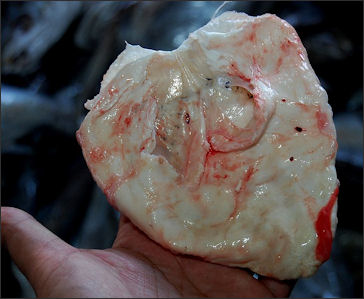Home | Category: Reef Fish / Ocean Fish
FISH CHARACTERISTICS
The primary fins possessed by most fish are: 1) the dorsal fin on the back; 2) the two pectoral fins on the sides behind the gills; 3) the two ventral fins on the bottom near the front; 4) theanal fin on the bottom near the back; and 5) the tail (caudal) fin. The fins are composed of a web of skin supported by horny rays. Boy fish lack hands of gripping forelimbs of any kind.
Most fish have scales which overlap like shingles on a roof. The scales grow with the fish and they produce rings like trees which reveal a great deal of data about the fish such as how much food they eat and when they lay their eggs. Over the scales is a layer of skin and a coating of slimy mucous.
Unlike humans, fish continue growing their entire lived. Old fish can be extremely large. The age of fish is estimated by counting lines of the scales or in otoliths, inner ear structure used in helping fish maintain balance. These lines are similar to the rings in a tree. In March 2007, a giant female shortraker rockfish caught in the Bering Strait that was over a meter long and weighed 27 kilograms was estimated to be around 100 years old based on lines in its scales and otoliths.
Most fish lay round, transparent eggs that contain oil globules to nourish the larvae. Their transparency allows them to hide better in the open water from predators. After they emerge from their eggs many creatures remain transparent so they can hide in plain site.
Related Articles: FISH: TYPES, HISTORY AND DEFINITIONS ioa.factsanddetails.com ; FISH BEHAVIOR, PERCEPTION, COMMUNICATION AND SCHOOLING ioa.factsanddetails.com ; FISH PERCEPTION AND COMMUNICATION ioa.factsanddetails.com; FISH REPRODUCTION, MATING, DEVELOPMENT AND PARENTING ioa.factsanddetails.com ; OCEAN PREDATORS AND FISH FEEDING BEHAVIOR ioa.factsanddetails.com
Websites and Resources: Animal Diversity Web (ADW) animaldiversity.org; National Oceanic and Atmospheric Administration (NOAA) noaa.gov; Fishbase fishbase.se ; Encyclopedia of Life eol.org ; Smithsonian Oceans Portal ocean.si.edu/ocean-life-ecosystems ; Woods Hole Oceanographic Institute whoi.edu ; Cousteau Society cousteau.org ; Monterey Bay Aquarium montereybayaquarium.org ; MarineBio marinebio.org/oceans/creatures
Developmental Characteristics of Ray-Finned Fishes
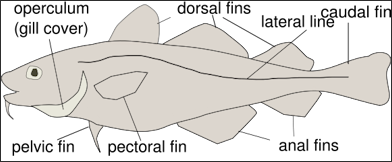
parts of a cod There is not a strong set of derived characters (characteristics not present in ancestral species) for ray-finned fish, but they are believed to be monophyletic (of a single phylum). Known ancestral features include structurally distinctive pelvic and pectoral girdles, heavy ganoid scales (heavy and complex scales composed of three layers), lepidotrichia (scales or scale-like features on the skin that form soft rays of the fins, which are segmented and dumbbell-shaped in cross-section), fins attached to the body by the fin rays (rather than with a fleshy lobe), branchiostegal rays (a series of long, curved bones supporting the gill membrane), and no internal nares (or choana — separate internal openings to the lungs). /=\
Barbara Carrol wrote: “In their great numbers and degree of anatomical diversity, the modern ray-finned fishes may be considered the most successful of all vertebrates”. According to Animal Diversity Web (ADW): “Modern teleosts (nearly all modern fish) represent the culmination of continuous ‘improvements’ on the basic fish design, within the Neopterygii. Investigators have traced these changes in the basic fish design with the aid of the fossil record, and have identified important trends in their evolution. Refinements in the structure of scales, branchiostegal rays, swim bladder, jaws, tail and fins have all contributed to the diverse radiation (increase in number of species) of ray-finned fishes. The trend among ray-finned fish has been toward lighter, more flexible bones and scales, an internal muscular-tendonous system, neutral buoyancy via the swim bladder, greater maneuverability, mobility and speed via changes in the tail and fins, and improvements in mouth structure. /=\
Scales that were heavy and complex and composed of three layers (ganoid) served as a relatively inflexible suit of armor for ancestral species of fish. Over millions of years the general trend in ray-finned fish has been to reduce weight and complexity and increase flexibility. The result is the elasmoid scale (ctenoid and cycloid), found in teleosts , which is thin, light, flexible and composed of only two layers (an external fibrous layer and an internal bony layer). In fact, many teleosts and all the surviving chondrosteans (sturgeons and paddlefishes) have taken the final step and shed their scales entirely. /=\
swim bladder Swim bladders probably functioned as a lung in the earliest ray-finned fish, but in more derived ray-finned fishes it is used primarily as a hydrostatic organ (to maintain buoyancy). With neutral buoyancy achieved by controlling the amount of gas in the swim bladder, the pectoral fins no longer needed to function as hydroplanes, so they evolved to aid in greater maneuverability. Finally, in some ray-finned fish, such as gouramies (and others), the swim bladder is utilized for non-respiratory functions such as hearing and sound production. /=\
Branchiostegal rays developed from the bones at the base of the branchial cavity, and increased the efficiency with which water was pumped across the gills (“two pump” respiratory system). The interopercular bones, which were formed by the modification of branchiostegal rays at the bottom of each gill cover (operculum), further improved the pumping efficiency by enlarging the opercular cavity, thus increasing the volume of water that could flow through the gills. Branchiostegal rays have also allowed ray-finned fish to utilize suction feeding methods, rather than simply grabbing — a function equally significant as improved respiration. /=\
Jaws developed in conjunction with the branchiostegal rays and show a trend towards more flexibility. Two major bones of the upper jaw, the maxilla, and the premaxilla, were previously firmly attached to the skull and had teeth. However, in recently derived ray-finned fish, there are fewer attachments and teeth are rarely present. This has allowed for the upper jaw to extend, making it protrusible (dramatically illustrated by some wrasses), and permitted a variety of feeding specializations to develop, such as plankton straining (usually zooplankton). One result of increased flexibility of the upper jaw has been that processing could not easily occur at the rim of the mouth any longer. Therefore, many fish with protrusible jaws have a second set of jaws in the throat, termed pharyngeal jaws , that process food and free the outer jaw to continue feeding. /=\
Tails evolved considerably over time. Changes in the lobes of the tail, from heterocercal (upper lobe longer than lower lobe) to homocercal (upper and lower lobes same size) in recently derived ray-finned fish, are also related to the achievement of neutral buoyancy. Heterocercal tails (still found in sharks) provide lift, which is unnecessary for neutrally buoyant fish. Homocercal tails provide uniform thrust and allow for precise movements (each ray can be controlled individually), which are quite important for fast-swimming, pelagic (living in the open ocean, far from land) fish and small, maneuverable fish, respectively. (See an illustration of locomotion in fish). /=\
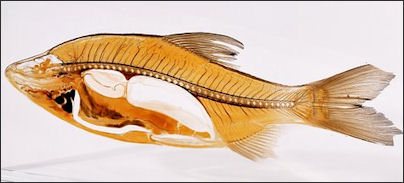
digestive organs Fins also changed quite a bit: With the loss of heavy, armoring scales, ray-finned fish developed spines, which are used as anti-predator devices when individuals are unable to use speed to escape. The positioning of the pelvic and pectoral fins also changed along with the achievement of neutral buoyancy. Instead of having pelvic fins located well behind the pectoral fins, in more derived ray-finned fish the pelvic fins are located just below or even slightly in front of the pectoral fins; here they aid in increased maneuverability instead of being used simply as stabilizers, as in earlier ray-finned fish. /=\
Synapomorphies (characteristics found in an ancestral species and shared by their evolutionary descendants) includes: 1) Branchiostegal rays and interopercular bone; 2) a swim bladder reduced in size and specialized for uses other than breathing, and primarily as a hydrostatic organ; 3) istinctive jaw structure — maxillae and premaxillae often lack teeth and disconnected from skull; 4) Homocercal tail; and 5) Distinctive structure of the pectoral girdle. /=\
Fish Lifespans and Longevity
Not surprisingly, the lifespan of fish varies widely. In general, smaller fish have shorter lives and vice versa. For instance, many smaller species live for only a year or less, such as North American minnows in the genus Pimephales, a few galaxiids from Tasmania and New Zealand, Sundaland noodlefishes , a silverside , a stickleback , and a few gobies .
However, researchers of coral reef fishes are beginning to find that this correlation does not hold for some families. While many people, especially in the business of fisheries, assumed short lifespans for many fish, researchers are starting to find that many live much longer than previously expected. For example, common species, such as the European perch (aka river perch) and largemouth bass can live 25 and 15 to 24 years respectively.
Even more impressive, some sturgeons (which are severely threatened) can live between 80 to 150 years. Several species of rockfish (deepwater rockfish , silvergray rockfish and rougheye rockfish) live from 90 to 140 years! These long lifespans have quickly become a serious issue for some fisheries because populations can be decimated if individuals that naturally accumulate in older age classes are removed (see Conservation). (Choat and Robertson, 2002; Helfman, et al., 1997) /=\
Breathing Fish, Their Swim Bladder and Buoyancy
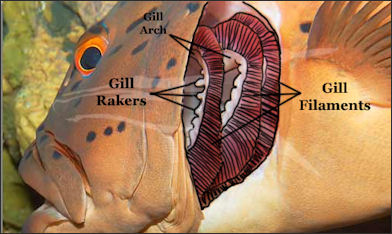
Fish gills Fish have hearts that pump blood through their bodies like terrestrial animals. Instead of lungs they use gills to inject oxygen into the blood. The gills are essentially filters that remove dissolved oxygen, which enters the blood stream through a delicate membrane of filaments. Straining devises called gill rakers prevent food and other object from striking the gills.
Most fish pump water across their gills using their head muscles. They breath by widening their jaws and sucking in water through their mouths and then squeezing their jaws shut to push the water through their gills.
Most fish also have an organ called an swim bladder between the stomach and backbone. An appendage of the intestine, it is filled with gas and its purpose is not completely understood although it believed to be involved in maintaining balance and buoyancy and allows a fish to swim easily at any depth.
The gas in the swim bladder is lighter than water. The fish can adjust buoyancy by regulating the volume and pressure of the gas in the bladder by moving gas between their bloodstream and the gas bladder. Gas enters the bladder through the gas gland which is supplied with blood by a network of vessels. The bladder of freshwater fish has a larger capacity than that of marine fish because freshwater is less dense than saltwater and does not support the fish’s body as well as saltwater.
Fish Digestion
Fish lack tongues. They rely on their jaws to the work done by both the jaws and tongue in mammals and reptiles. Many predatory fish rely in suction to pull prey into their mouths. Many fish eat their food whole. Others have sharp teeth and break their food into pieces that are swallowed whole. The vast majority of fish have a second set of jaws deep down their throat which break food as it goes down the gullet.
The back-of-the-throat choppers are called pharyngeal jaws. Adam Summers, a professor of bioengineering at the University of California at Irvine, wrote in Natural History magazine, they “can split, slice, tear or crush food as it goes down the gullet...and they come in an astonishing array of size, shapes and functions — all derived from gill arches, which hold in place the bright respiratory structures that lie behind the cheeks of most fishes. Pharyngeal jaws are equipped with their own set of teeth and move completely independently of the real jaws. Still, the problem persists on how to move prey back down from the mouth jaws to the throat. Suction generally works.”
The pharyngeal jaws on moray eels are like a second creature living inside the eel. See Moray Eels.
Streamlined Fish
Fish are very streamlined. They have to be. Water is 800 times more dense than air and slight protrusions are more disruptive for a fish than for a bird. Eyes bulge barely above the surface and plates covering the gills fit close to the body. The coating of slim over the scales reduce drag and friction.
The fastest fish have bodies that are pointed in the front, grow quickly to maximum diameter and then tapper gently towards the tail. Along the top and bottom edges of the body on either side of the tail are tiny triangular blades that act as spoilers to prevent turbulence. The fastest swimmers like tuna have a deeply forked, half-moon tail.
Gray's Paradox is scientific problem first addressed in 1936 that explains why tuna, dolphin and other sea creatures swim as fast as they do when it seems they only have one seventh of the muscle to achieve this.
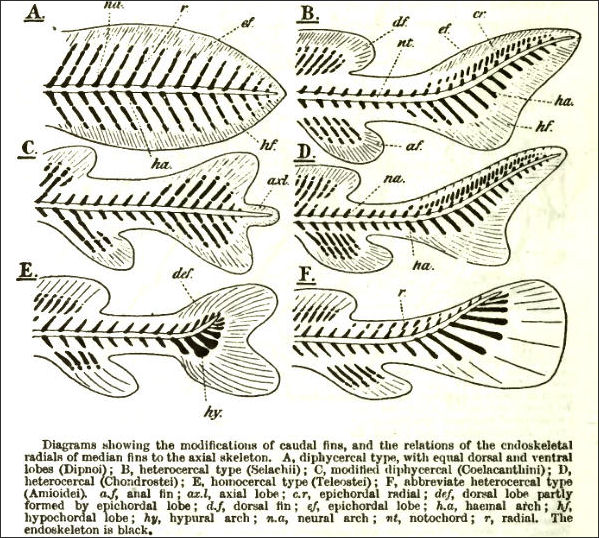
fish tails
Moving Fish
Fish move through the water by sweeping the tail fin laterally and moving their body back and forth with sideways muscular movements. The rear half of the fish is like an engine. Powerful muscles are attached to backbone that allow the tail to beat from side to side continuously throughout a fish’s life.
The other fins — the pectoral, pelvic and dorsal fins — are used primarily for stability and maneuvering and braking. Fish have fins at the fore and aft that swivel in almost any direction and give it great maneuverability in water. When the fish move at great speeds and stability is generated by the speed the fins tuck into slots, making the body is streamlined.
Many fish can quickly shoot forward from a resting position shooting water out of their gills. Flatfish are able to jump off the bottom of the ocean using the same method. Many open sea fish migrate between breeding ground and feeding grounds, often saving energy by riding the currents.
When a ship moves through the water drag is created by vortices that spin off the hull. Fish flex their bodies in such a way that the vortices roll off and no longer produce drag. Through the lateral motion of the body, the vortices roll down the sides and off the tail and in doing this create propulsion forces rather than drag.
Fastest and Slowest Fish — in Terms of Distance Swimming
A research team led by Yuki Watanabe, an associate professor of marine zoology at the National Institute of Polar Research, compared the long-distance cruising speeds of 46 species of fish in a paper published in April 2016 on the Proceedings of the U.S. National Academy of Sciences. It showed that a 428-kilogram great white shark swam the fastest at 8.1 kilometers per hour (kph (5 miles per hour (mph)), followed by a 240-kilogram bluefin tuna at 7.2 kph (3.5 mph). This compares with 3.1 kph (1.9 mph) of a 2.2-ton whale shark, a speed not unexpected considering its huge body. Sunfish and salmon were the slowest: : An 87-kilogram sunfish swam at 2.2 kph (1.4 mph) and a 3.3-kilogram salmon at 2.7 kph (1.7). The scientists used small monitoring systems attached to fish. The high speeds of the sharks and tuna are attributed to their unique body system that has evolved to keep their body temperatures relatively high. [Source: Earth.com, January 16, 2017]
According to Earth.com: “A 2.2-ton whale shark swam much faster than expected at 3.1 kph. The speed of fish with higher body temperatures is comparable to marine mammals who maintain a body temperature independently of their environment. The speed of the slower fish is much like that of reptiles, who cannot regulate their body temperature from within. “As a rule, the speeds of marine animals are decided by body temperature first, followed by body size,” Watanabe said.
“The shark is a cartilaginous fish while tuna have a bony skeleton. However, great white sharks and bluefin tuna have a common anatomy that makes them faster than other fish. Both have dark muscles where many blood vessels meet. Fish with lower body temperatures have very few blood vessels close to the surface of their bodies. These species of sharks and tuna also have a common structure called a rete mirabile. This a complex system of veins with cold blood and arteries with warm blood lying close together to prevent heat from escaping the body.
“As hunters of the outer seas where they are less concealed and more vulnerable to attack, speed is critical to the survival of great white sharks and bluefin tuna. The resemblance between these fish is a result of “convergence,” which is the evolution of unrelated animals to develop similar body characteristics in a common environment.
Fish with the Strongest Bites: Piranhas Beat Out Great White Sharks
Piranhas have the strongest bite of any animal, including great white sharks, hyenas and even Tyrannosaurus T Rex according to a study published in 2012 in Scientific Reports. AFP reported: Outsized jaw muscles allow the black piranha to exert bite force equivalent to 30 times its bodyweight, a feat unmatched in the natural world, according to results of a finger-risking study published Other animals like the great white shark, the hyena and the alligator can deliver more forceful bites, but their crunching power becomes much less impressive when viewed in relation to their overall size and weight, it said. In fact, relative to their size, piranhas outperform even prehistoric monsters like Tyrannosaurus rex and the whale-chomping megalodon, a massive shark that preceded the great white, said the study. [Source: AFP, December 20, 2012]
“The research saw scientists catch 15 black piranhas in Brazil's Amazon River basin and risk their digits by teasing a customised force gauge between their serrated jaws. The fish, ranging from about 20 to 37 centimeters (eight to 15 inches) in length, "readily performed multiple defensive bites" on the gadget, wrote the team from the United States, Egypt and Brazil. This was the first live measurement of bite force taken from the black piranha (Serrasalmus rhombeus), the largest of the notoriously carnivorous species.
Such undertakings are "rare, dangerous and difficult to perform," wrote the research team. Bite force quotients — considering both bite force and body size — compare the powerful bites of black piranha (S. rhombeus) and now-extinct Megapiranha (M. paranensis) with barracuda, blacktip shark (C. limbatus), bull shark (C. leucas), hammerhead shark (S. mokarran), the extinct 4-ton Dunkleosteus terrelli, great white shark (C. caracharias) and the extinct whale-eating Carcharodon megalodon.
"While anecdotes of piranha-infested waters skeletonising hapless victims are generally hyperbole, the effectiveness of their bite is not," the scientists added. They pointed to "documented cases of S. rhombeus biting off and consuming human phalanges" — the bones found in fingers and toes.The measured bite force of the black piranha, at 320 newton (N), was nearly three times greater than that exerted by an American alligator of comparative size, said the study. One newton is the force required to move a kilogramme (2.2 pounds) of mass at one meter (3.25 feet) per second squared.
The piranha has jaw muscles of an "extraordinary" size and a highly modified jaw-closing lever, said the team. In fact, the muscle complex makes more than two percent of the black piranha's total body mass. The team also used the data they gathered to estimate the bite force of the extinct Megapiranha paranensis to have been between 1,240 and 4,749 N. The fish from the Miocene period, which ended about five million years ago, would have been about 70 centimeters long and weighed about 10 kilogrammes (22 pounds), they said. "Our analysis predicts Megapiranha's bite was equivalent to the anterior bite force of a great white shark weighing over 400 kilos (880 pounds)," said the report.

Sci-News See Image Sources Below Sources Below
And though their diet remains a secret of history, the monster fish would have been able to crush turtles, armoured catfish and even larger terrestrial animals. "If our fossil reconstructions and simulations are correct, then Megapiranha paranensis was indeed a ferocious bone-crushing mega-predator of the Miocene epoch," just like its modern-day relative, said the report. "Our results for living and extinct species validate the fearsome predatory reputations of piranhas."
Image Sources: Wikimedia Commons; YouTube, Animal Diversity Web, NOAA, Fastest chart: beachchairscientist.com; Strongest Bite Chart: Sci-News sci.news]
Text Sources: Animal Diversity Web (ADW) animaldiversity.org; National Oceanic and Atmospheric Administration (NOAA) noaa.gov; Wikipedia, National Geographic, Live Science, BBC, Smithsonian, New York Times, Washington Post, Los Angeles Times, The New Yorker, Reuters, Associated Press, Lonely Planet Guides and various books and other publications.
Last Updated March 2023


